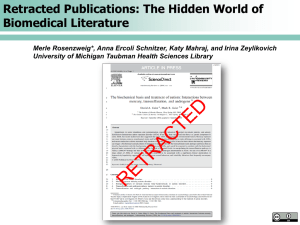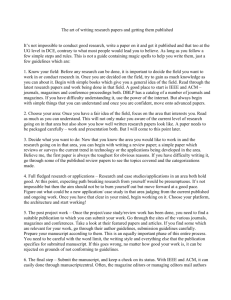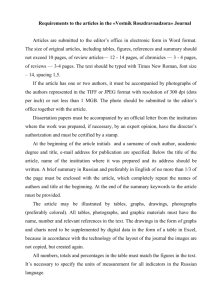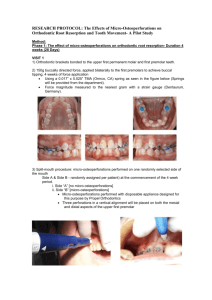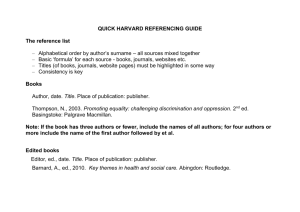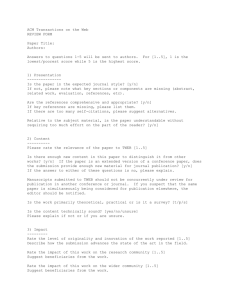WWW.PUBLICATIONETHICS.ORG - Committee on Publication
advertisement
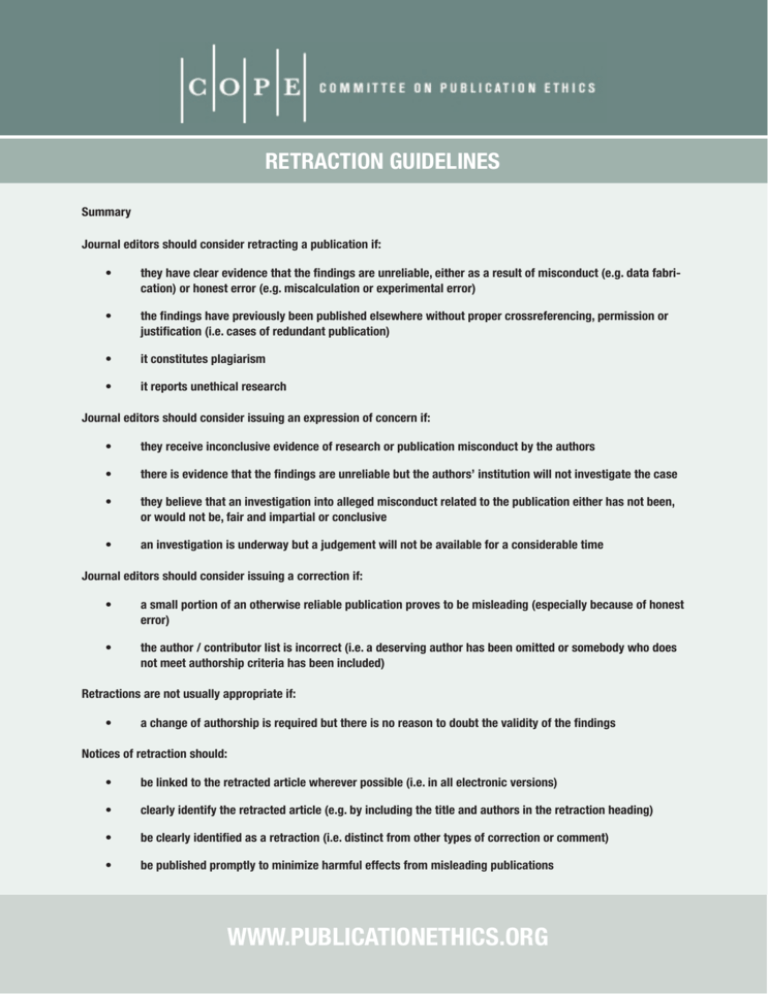
RETRACTION GUIDELINES Summary Journal editors should consider retracting a publication if: • they have clear evidence that the findings are unreliable, either as a result of misconduct (e.g. data fabrication) or honest error (e.g. miscalculation or experimental error) • the findings have previously been published elsewhere without proper crossreferencing, permission or justification (i.e. cases of redundant publication) • it constitutes plagiarism • it reports unethical research Journal editors should consider issuing an expression of concern if: • they receive inconclusive evidence of research or publication misconduct by the authors • there is evidence that the findings are unreliable but the authors’ institution will not investigate the case • they believe that an investigation into alleged misconduct related to the publication either has not been, or would not be, fair and impartial or conclusive • an investigation is underway but a judgement will not be available for a considerable time Journal editors should consider issuing a correction if: • a small portion of an otherwise reliable publication proves to be misleading (especially because of honest error) • the author / contributor list is incorrect (i.e. a deserving author has been omitted or somebody who does not meet authorship criteria has been included) Retractions are not usually appropriate if: • a change of authorship is required but there is no reason to doubt the validity of the findings Notices of retraction should: • be linked to the retracted article wherever possible (i.e. in all electronic versions) • clearly identify the retracted article (e.g. by including the title and authors in the retraction heading) • be clearly identified as a retraction (i.e. distinct from other types of correction or comment) • be published promptly to minimize harmful effects from misleading publications WWW.PUBLICATIONETHICS.ORG RETRACTION GUIDELINES • be freely available to all readers (i.e. not behind access barriers or available only to subscribers) • state who is retracting the article • state the reason(s) for retraction (to distinguish misconduct from honest error) • avoid statements that are potentially defamatory or libellous The purpose of retraction Retraction is a mechanism for correcting the literature and alerting readers to publications that contain such seriously flawed or erroneous data that their findings and conclusions cannot be relied upon. Unreliable data may result from honest error or from research misconduct. Retractions are also used to alert readers to cases of redundant publication (i.e. when authors present the same data in several publications), plagiarism, and failure to disclose a major competing interest likely to influence interpretations or recommendations. The main purpose of retractions is to correct the literature and ensure its integrity rather than to punish authors who misbehave. What form should a retraction take? Notices of retraction should mention the reasons and basis for the retraction, to distinguish cases of misconduct from those of honest error; they should also specify who is retracting the article. They should be published in all versions of the journal (i.e. print and/or electronic). It is helpful to include the authors and title of the retracted article in the retraction heading. Retracted articles should be clearly identified as such in all electronic sources (e.g. on the journal website and any bibliographic databases). Editors are responsible for ensuring that retractions are labelled in such a way that they are identified by bibliographic databases (which should also include a link to the retracted article). The retraction should appear on all electronic searches for the retracted publication. Retracted articles should not be removed from printed copies of the journal (e.g. in libraries) nor from electronic archives but their retracted status should be indicated as clearly as possible. WWW.PUBLICATIONETHICS.ORG RETRACTION GUIDELINES Which publications should be retracted? If only a small part of an article reports flawed data, and especially if this is the result of genuine error, then the problem is best rectified by a correction or erratum. (The term erratum usually refers to a production error, caused by the journal. The term corrigendum (or correction) usually refers to an author error.) Partial retractions are not helpful because they make it difficult for readers to determine the status of the article and which parts may be relied upon. Similarly, if only a small section of an article (e.g. a few sentences in the discussion) is plagiarised, editors should consider whether readers (and the plagiarised author) would be best served by a correction (which could note the fact that text was used without appropriate acknowledgement) rather than retracting the entire article which may contain sound, original data in other parts. Retraction should usually be reserved for publications that are so seriously flawed (for whatever reason) that their findings or conclusions should not be relied upon. If redundant publication has occurred (i.e. authors have published the same data or article in more than one journal without appropriate justification, permission or crossreferencing) the journal that first published the article may issue a notice of redundant publication but should not retract the article unless the findings are unreliable. Any journals that subsequently publish a redundant article should retract it and state the reason for the retraction. If an article is submitted to more than one journal simultaneously, and is accepted and published in both journals (either electronically or in print) at the same time, precedence may be determined by the date on which a licence to publish or a copyright transfer agreement was signed by the authors. In cases of partial overlap (i.e. when authors present some new findings in an article that also contains a substantial amount of previously published information) editors need to consider whether readers are best served if the entire article is retracted or whether it would be best to issue a notice of redundant publication clarifying which aspects had been published previously and providing appropriate cross-references to the earlier work. This will depend on the amount of overlap. Editors should bear in mind that the main purpose of retractions is to correct the literature and ensure its integrity rather than to punish authors who misbehave. Only published items can be retracted. Guidelines on dealing with redundant publications identified in submitted manuscripts can be found in the relevant COPE flowchart [http://publicationethics.org/files/u2/01A_Redundant_ Submitted.pdf]. Posting a final version on a website constitutes publication even if an article has not appeared (or will not appear) in print. If an article is retracted before it appears in the print version of a journal, the electronic version should be retained on the journal’s website with a clear notice of retraction and it should be included on bibliographic databases (e.g. with a digital object identifier [doi] or other permanent citation that will locate it) even if it does not appear in the printed journal and therefore does not receive a page allocation. This is because electronic versions may already have been accessed and cited by researchers who need to be alerted to the fact that the article has been retracted. WWW.PUBLICATIONETHICS.ORG RETRACTION GUIDELINES Who should issue the retraction? Articles may be retracted by their author(s) or by the journal editor. In some cases, retractions are issued jointly or on behalf of the journal’s owner (e.g. a learned society or publisher). However, since responsibility for the journal’s content rests with the editor s/he should always have the final decision about retracting material. Journal editors may retract publications (or issue expressions of concern) even if all or some of the authors refuse to retract the publication themselves. When should a publication be retracted? Publications should be retracted as soon as possible after the journal editor is convinced that the publication is seriously flawed and misleading (or is redundant or plagiarised). Prompt retraction should minimize the number of researchers who cite the erroneous work, act on its findings or draw incorrect conclusions, such as from ‘double counting’ redundant publications in meta-analyses or similar instances. If editors have convincing evidence that a retraction is required they should not delay retraction simply because the authors are not cooperative. However, if an allegation of misconduct related to a potential retraction results in a disciplinary hearing or institutional investigation, it is normally appropriate to wait for the outcome of this before issuing a retraction (but an expression of concern may be published to alert readers in the interim – see below). What should editors do in the face of inconclusive evidence about a publication’s reliability? If conclusive evidence about the reliability of a publication cannot be obtained (e.g. if authors produce conflicting accounts of the case, authors’ institutions refuse to investigate alleged misconduct or to release the findings of such investigations, or if investigations appear not to have been carried out fairly or are taking an unreasonably long time to reach a conclusion) editors should issue an expression of concern rather than retracting the publication immediately. Such expressions of concern, like retraction notices, should be clearly linked to the original publication (i.e. in electronic databases and by including the author and title of the original publication as a heading) and should state the reasons for the concern. If more conclusive evidence about the publication’s reliability becomes available later, the expression of concern should be replaced by a notice of retraction (if the article is shown to be unreliable) or by an exonerating statement linked to the expression of concern (if the article is shown to be reliable and the author exonerated). Should retraction be applied in cases of disputed authorship? Authors sometimes request that articles are retracted when authorship is disputed after publication. If there is no reason to doubt the validity of the findings or the reliability of the data it is not appropriate to retract a publication solely on the grounds of an authorship dispute. In such cases, the journal editor should inform those involved in the dispute that s/he cannot adjudicate in such cases but will be willing to publish a correction to the author/contributor list if the authors/contributors (or their institutions) provide appropriate proof that such a change is justified. WWW.PUBLICATIONETHICS.ORG RETRACTION GUIDELINES (For authorship disputes occurring before publication, see the relevant COPE flowcharts. http://publicationethics.org/ files/u2/04A_Author_Add_Submitted.pdf and http://publicationethics.org/files/u2/04B_Author_Remove_Submitted. pdf) Can authors dissociate themselves from a retracted publication? If retraction is due to the actions of some, but not all, authors of a publication, the notice of retraction should mention this. However, most editors consider that authorship entails some degree of joint responsibility for the integrity of the reported research so it is not appropriate for authors to dissociate themselves from a retracted publication even if they were not directly culpable of any misconduct. Are there grounds for legal proceedings if an author sues a journal for retracting, or refusing to retract, a publication? Authors who disagree with a retraction (or whose request to retract a publication is refused) sometimes threaten journal editors with legal action. Concern over litigation can make editors reluctant to retract articles, especially in the face of opposition from authors. Journals’ instructions for authors should explain the retraction procedure and describe the circumstances under which articles might be retracted. This information should be incorporated (e.g. by references) into any publishing agreements and brought to the authors’ attention. However, even if the publishing agreement or journal instructions do not set out specific conditions for retraction, authors usually would not have grounds for taking legal action against a journal over the act of retraction if it follows a suitable investigation and proper procedures. However, legal advice may be helpful to determine appropriate wording for a notice of retraction or expression of concern to ensure that these are not defamatory or libellous. Nevertheless, retraction notices should always mention the reason(s) for retraction to distinguish honest error from misconduct. Whenever possible, editors should negotiate with authors and attempt to agree a form of wording that is clear and informative to readers and acceptable to all parties. If authors consent to the wording of a retraction statement, this provides defence against a libel claim. However, prolonged negotiations about wording should not be allowed to delay the publication of a retraction unreasonably and editors should publish retractions even if consensus cannot be reached. WWW.PUBLICATIONETHICS.ORG RETRACTION GUIDELINES Further reading ICMJE guidelines: http://www.icmje.org/publishing_2corrections.html Sox HC & Rennie D. Research misconduct, retraction, and cleansing the medical literature: lessons from the Poehlman case. Annals of Internal Medicine 2006;144:609-13 Nath SB, Marcus SC & Druss BG. Retractions in the research literature: misconduct or mistakes? MJA 2006;185:1524 Budd JM. Sievert M, Schultz TR. Phenomena of retraction. JAMA 1998;280:296-7 © 2009 COPE. This is an open-access article distributed under the terms of the Creative Commons Attribution License, which permits unrestricted use, distribution, and reproduction in any medium, provided the original author and source are credited. September 2009 Elizabeth Wager, Virginia Barbour, Steven Yentis, Sabine Kleinert on behalf of COPE Council WWW.PUBLICATIONETHICS.ORG
